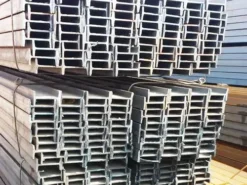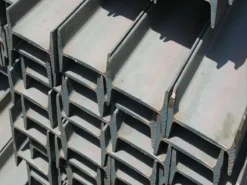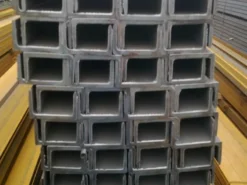Angle steel is a long strip of steel with two sides perpendicular to each other. There are equilateral angle steel and unequal angle steel. The width of both sides of the equilateral angle steel is equal. Its specifications are expressed in millimeters of side width × side width × side thickness.
-Classification:
It is mainly divided into two types: Equilateral angle steel and Unequal angle steel.
Unequal angle steel can be divided into two types: unequal sides and equal thickness and unequal sides and unequal thickness.
The specifications of angle steel are expressed by the dimensions of side length and side thickness. Domestic angle steel specifications range from No. 2 to No. 20, with the number in centimeters of side length being the number. The same angle steel often has 2 to 7 different side thicknesses. Imported angle steel indicates the actual size and thickness of both sides and the relevant standards. Generally, those with a side length of more than 12.5cm are large angle steels, those with a side length between 12.5cm and 5cm are medium-sized angle steels, and those with a side length of less than 5cm are small angle steels.
The cross-sectional height of the unequal angle steel is calculated according to the long side width of the unequal angle steel. Refers to steel with an angular cross-section and unequal lengths on both sides. It is a kind of angle steel. Its side length ranges from 25mm×16mm to 200mm×125mm. Rolled by hot rolling mill. General unequal angle steel specifications are: ∟50*32~∟200*125, thickness 4-18mm.
-Application scope:
Q235B angle steel can be composed of various stress-bearing components according to different needs of the structure, and can also be used as a connector between components. It is widely used in various building structures and engineering structures, such as roof beams, bridges, transmission towers, lifting and transportation machinery, ships, industrial furnaces, reaction towers, container racks and warehouse shelves, etc.
Angle steel is a carbon structural steel used in construction. It is a simple cross-section steel material. It is mainly used for metal components and factory building frames. It requires good weldability, plastic deformation performance and certain mechanical strength during use. The raw material billet for the production of angle steel is low carbon square steel billet, and the finished angle steel is delivered in a hot-rolled, normalized or hot-rolled state.
-Equilateral angle steel specifications and models:
2.5#: 25*25*3=1.124kg/m, 25*25*4=1.459kg/m
3#: 30*30*3=1.373kg/m, 30*30*4=1.786kg/m
4#: 40*40*3=1.852kg/m, 40*40*4=2.422kg/m, 40*40*5=2.976kg/m
5#: 50*50*4=3.059kg/m, 50*50*5=3.77kg/m, 50*50*6=4.465kg/m,
6#: 60*60*5=4.57kg/m, 60*60*6=5.42kg/m
7#: 70*70*5=5.397kg/m, 70*70*6=6.406kg/m,70*70*8=8.373kg/m
7.5#: 75*75*5=5.818kg/m, 75*75*6=6.905kg/m, 75*75*7=7.976kg/m
8#: 80*80*6=7.376kg/m, 80*80*8=9.658kg/m, 80*80*10=11.874kg/m
9#: 90*90*8=10.946kg/m, 90*90*10=13.476kg/m, 90*90*12=15.94kg/m
10#: 100*100*6=9.366kg/m, 100*100*8=12.276kg/m, 100*100*10=15.12kg/m, 100*100*12=17.898kg/m
11#: 110*110*8=13.532kg/m, 110*110*10=16.69kg/m,110*110*14=22.809kg/m
12.5#: 125*125*8=15.504kg/m, 125*125*10=19.133kg/m, 125*125*14=26.193kg/m
14#: 140*140*10=21.488kg/m, 140*140*12=25.522kg/m, 140*140*14=29.49kg/m
16#: 160*160*12=29.391kg/m, 160*160*14=33.987kg/m, 160*160*16=38.518kg/m, 160*160*18=48.634kg/m
18#: 180*180*12=33.159kg/m, 180*180*14=38.383kg/m, 180*180*16=43.542kg/m,180*180*18=48.634kg/m
20#: 200*200*14=42.894kg/m, 200*200*16=48.68kg/m, 200*200*18=54.401kg/m, 200*200*20=60.056kg/m
-Unequal Angle Steel:
Q235B: 56*36*4, 63*40*5, 75*50*6, 100*63*6*9m, 125*80*10*9m, 110*70*8*9m, 160*100*10*9m…
-Chemical Composition:
(1) Composition index: The chemical composition of angle steel belongs to the general structural rolled steel series, and the main verification indexes are C, Mn, P, and S. The content varies depending on the brand. The general range is C<0.22%, Mn: 0.30-0.65%, P<0.060%, S<0.060%.
(2) Inspection methods: When testing the above chemical components, commonly used standard inspection methods include GB223, JISG1211-1215, BS1837, BS Manual 19, ГОСТ22536, etc.
-Performance: The inspection items are mainly tensile test and bending test. Indicators include yield point, tensile strength, elongation and bending qualification.
-Weight calculation formula:
Weight per meter = 0.00785 × (side width + side width – side thickness) × side thickness










